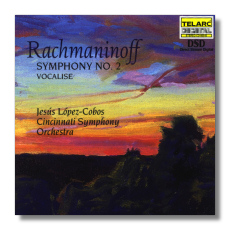
The Internet's Premier Classical Music Source
Related Links
- Rachmaninoff Reviews
- Latest Reviews
- More Reviews
-
By Composer
-
Collections
DVD & Blu-ray
Books
Concert Reviews
Articles/Interviews
Software
Audio
Search Amazon
Recommended Links
Site News
 CD Review
CD Review
Sergei Rachmaninoff

Symphony #2
- Symphony #2 in E minor, Op. 27 (1908)
- Vocalise, Op. 34/14 (1915)
Cincinnati Symphony Orchestra/Jesús López-Cobos
Telarc CD-80543 DDD 65:47
For me, the dominant Rachmaninoff Second of the digital era was recorded by Telarc in 1985. André Previn and the Royal Philharmonic Orchestra outdid themselves on this disc (Telarc CD-80113); since then, no recording of this symphony has been so exciting, passionate, and gratifying to lovers of first-class orchestral playing.
Telarc now enters into competition with itself with this new release. López-Cobos and the Cincinnati Symphony Orchestra have recorded extensively for this label, with emphases on Mahler, Bruckner, and Respighi; the Russian repertoire has been all but absent. This disc suggests that the affinity has been there all along, however.
López-Cobos and Previn differ little in their interpretation of this score. Both play it without cuts, which is the right thing to do these days, however unusual it was forty years ago and earlier. López-Cobos is a bit more expansive in the opening movement, but he is faster in the remaining three. The biggest difference comes in the Adagio. Previn lingered over this movement, stretching the timing to a heart- and breath-stopping 17:07. López-Cobos takes a more moderate 14:58. Many conductors are faster than that, and López-Cobos doesn't sound at all rushed. With generally faster tempos, López-Cobos realizes a subtly sinister element in Rachmaninoff's score. The finale, for example, is triumphant, but one is made vaguely uncomfortable by it all. (This interpretation is valid.)
Previn phrased more flexibly than the Spanish-born conductor, who sometimes seems unwilling to bend Rachmaninoff's sinuous lines. At the same time, his approach to tempo is fairly plastic – more plastic than Previn's, really – so López-Cobos can't be faulted for playing this score metronomically. His tempo adjustments, which are mostly subtle, don't feel obtrusive, but only time will tell whether they lose their spontaneity on repeated hearings.
The Vocalise, which was not on Previn's recording, comes as a quiet postlude to the Second's drama. As a more static piece of music, it makes a less strong impression on this recording than the symphony does.
The Cincinnati strings aren't as rich as the RPO's, and the orchestra as a whole doesn't play with quite the same effortless virtuosity. Nevertheless, the leaner sound matches López-Cobos's slightly more dynamic interpretation, and I was consistently thrilled by the sounds that the orchestra was making.
This is a Direct Stream Digital (DSD) recording. Telarc claims a 0-100,000 Hz frequency response with this technology, and a dynamic range of greater than 120 dB. Super Bit Mapping Direct has been used to convert the DSD digital signal to CD. The sound is nothing less than spectacular. It is warm, spacious, dramatic, yet unexaggerated. The goal of realism is brought one step closer here.
Copyright © 2001, Raymond Tuttle





















